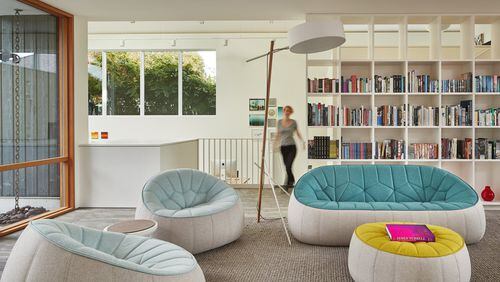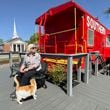SEATTLE — It’d be so easy to say Llew and Savina Mason “thought outside the box” when they envisioned their mindfully contemporary Central District home. It’d be true, because that’s what they do, but it wouldn’t be enough: They thought against the box.
Right off the bat, when they first met with Heliotrope Architects’ Mike Mora, “I gave Mike a sketch on a place mat: Don’t do this! No box,” Savina says. “We wanted our home to fit into the neighborhood. It’s a decent thing to do.”
The Masons are far too hip to be square. As is their new home.
They love this neighborhood; their last home was just two blocks away. This time, “We tried to get the biggest lot in the Central District and use maximum space for the house,” Llew says — but not sky-high into typical box territory, even if that is where the best views live.
“The shape, size and construction of the house were all about fitting in well to the overall physical character of the street … with the scale, massing and pitched roof riffing off of a classic bungalow,” Mora says — midblock in a neighborhood of classic Seattle cottages and bungalows. “We were trying to achieve a nonfussy, quiet, low-ego design that deferred to the interesting lives of the house’s occupants: the house as frame, not subject.”
In this case, frame and subjects are exceptionally interesting. And “frame” is especially apt: Mora calls this home Artist in Residence.
Savina is the artist; she works in encaustic, and also has an architecture degree from the Harvard Graduate School of Design. Llew runs technology for Amazon’s supply chain. Together, they also are, depending on whom you ask, “gardeners” or “enthusiastic amateurs,” and unequivocally unified roommates to a bearlike German shepherd named Ursa.
Mora says there’s “definitely a right-brain/left-brain dynamic between them,” but both sides align perfectly in their supremely customized home: It’s minimally detailed, impeccably decorated (interior designers need not apply), and maximally open and connected (there are only two interior doors).
“The idea was to be able to see a garden from every room,” Llew says. “We sat with Mike and went over thousands of photos we liked: Japanese temples, gazebos, connected walkways, courtyards. Every single room opened to outside. Mike drew essentially a checkerboard on a napkin: five living areas (in white); the black areas were courtyards. That was the first thing he handed us.”
First instincts usually are good instincts. (Also, there was a lot of tabletop drawing going on.)
“The house plan alternates between interior spaces and exterior spaces around the building,” Mora says. “The center space is the main living/dining room, and it extends from the front entry court to the rear patio court, allowing visual penetration from the backyard through to the street in front. The main floor is elevated above the street, with the front door tucked into the entry court, creating privacy. It’s sort of a you-can-see-out-but-they-can’t-see-in effect.”
What you can see from the street is a single box-defying peak. Inside it, two mutual must-haves: a functioning art studio/home office and a private guest wing. The light and white studio both establishes separation and maintains connection, Mora says: It’s directly attached to the living area but half a level lower, under a soaring, skylighted ceiling.
The other elevated form, on the opposite end, holds the clever, convention-defying master suite, in two parts: The bedroom is upstairs; the bathroom is not.
“I was vaguely worried about the workout, but quite honestly it’s not a big deal at all,” Llew says — plus, there is great reward for the effort: a custom Western red cedar, Japanese-inspired soaking tub, a soothing splurge among ocean-essence turquoise glass tile and sparkling high-end fixtures.
“A master bath below is something 9 out of 10 clients probably wouldn’t buy,” Mora says.
Clearly, Llew and Savina are not boxed into any this-is-how-things-are-always-done majority — or any box at all, for that matter. Just a perfectly personalized frame.
“The house really fits us — how we live, how we interact,” Savina says. “There’s nothing extra, nothing missing. The whole thing is completely custom. You can’t make the argument you need it, but my Lord, we appreciate it. We are very grateful.”
About the Author






